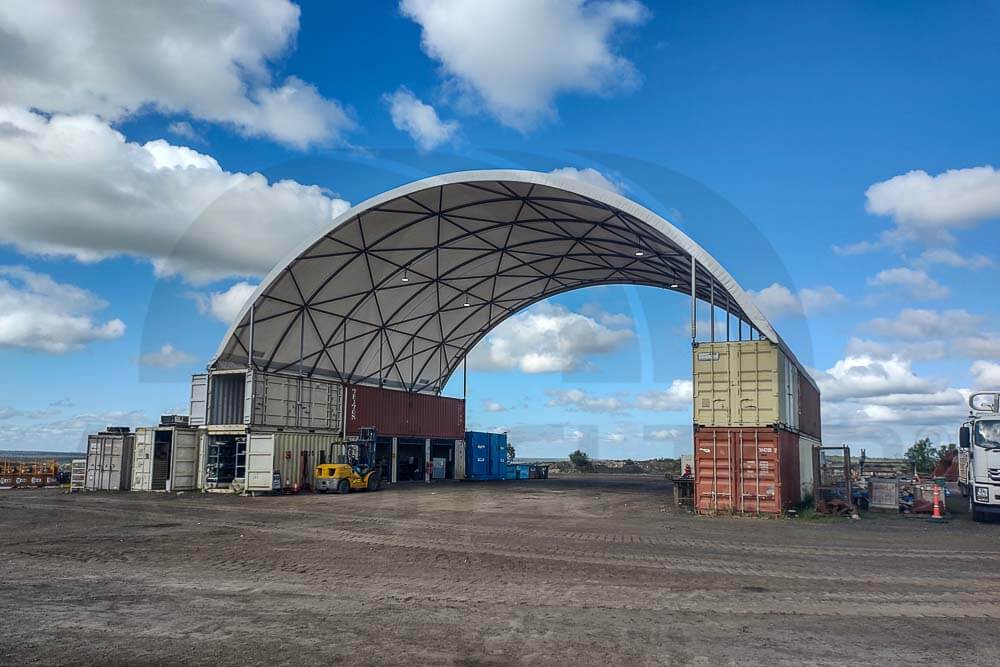The truth is that fabric shelters can last as long as you need them to. The steel frames last for a very long time, and the fabric covers are known to last 20 years before you’d need to replace them. There are a few things to consider when it comes to getting the best lifespan out of your fabric shelter:
- Researching before you purchase a fabric shelter
- Cover tensioning
- Shelter foundations or tie-down
- Conducting regular audits or checks
In this quick video Daryl explains everything you need to know about getting the best lifespan out of your shelter.
Fabric Shelter Research
It pays to do some research before purchasing a fabric shelter. What’s important to you? Are you concerned about compliance and safety? Here are a few points to consider:
- Wind Region – are you located in a high wind region area? If so you’ll want to make sure your fabric shelter is designed and engineered accordingly.
- Warranty – a company providing an engineered shelter will be able to provide you with a warranty; usually more than 5 years.
- Engineering – do you need a compliant structure? Non-engineered shelters aren’t designed for the Australian weather conditions. Check out this article on the importance of fabric shelter engineering.
- Permanent Vs Temporary – how long do you need the shelter for? If your shelter is a permanent solution and will be up for a few years or more you’ll want a shelter that’s going to last.
Check out some of our other tips and advice to help you with your fabric shelter research.
- How Can I Choose the Right Shelter Size and Model for My Project?
- How Easy Is It to Install and Dismantle an Allshelter?
- Curved Steel Structure: What Is It and Its Benefits in Construction
- The Science Behind Allshelter’s Container Shelters: How They Work
- Why Use Fabric Shelters Instead of Traditional Buildings?
Cover Tensioning
The tensioning of the cover can make a huge difference to the longevity of your shelter. When you’re installing the fabric shelter cover, take care to ensure that there’s even tension. This will remove any stress from the seams and joints.
When observed from the outside, the fabric should be firm without any crinkles and look mostly flat between the frames. The cover is over-tensioned if there is pulling or large dips between the frames. This causes excessive stress on the fabric seams which will result in the cover wearing out faster.
But, if the cover is too loose and flaps with the wind, this can also be damaging to the cover seams and joins.
See below example of a poorly tensioned fabric shelter (pictured on the left hand side) vs a well tensioned shelter (pictured on the right hand side).
Fabric Shelter Foundations or Tie-Down
Every shelter structure, no matter how big or small it is needs some type of foundations. The most common types of foundations for fabric structures include ballast (for shipping containers) or footings. There is a lot of misconception around tie-down. Many people think that the weight of the shipping containers is enough to hold a container shelter down. It’s not, unless it’s a very small shelter in a low wind region area.
Conducting Regular Audits & Repairs
Conducting regular checks of your shelter is a great idea to maintain the longevity of your shelter. Allshelter offers an audit service, which is often used by remote mine sites with multiple structures. These audits cover things like:
- Reviewing engineering plans & wind ratings; and checking the shelter against those plans to make sure its correct. Checking the wind ratings is especially important if you relocate your shelters.
- Structural review – checking footings, framework, bracing, bolts, brackets and other connection points.
- Fabric cover tensioning review
- Checking for general wear and tear
Once the audit has been conducted, there’s sometimes a need to do repairs which can involve replacing parts.
Check out this webpage for more information on Audits & Repairs.
So as you can see fabric shelter lifespan is dependent on a few things. But, if anything, remember this: a well tensioned, engineered & quality fabric shelter will last much longer than a non-engineered, cheap, imported shelter.
